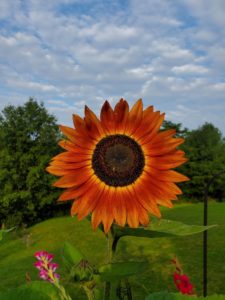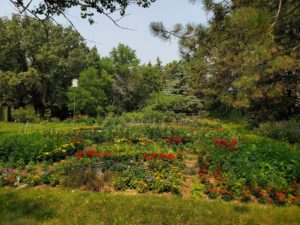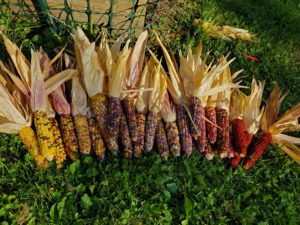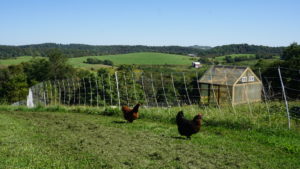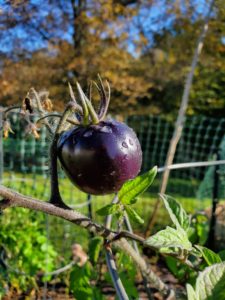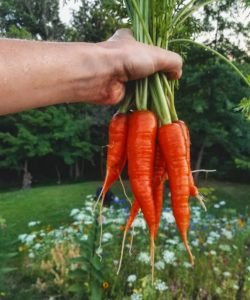
Growing your own food and saving your own seeds is a radical act of self-sufficiency. In our modern, fast-paced world, many people would say food comes from “the supermarket” and couldn’t recognize the plants that grow their food. That isn’t the fault of most people who are busy working two jobs just to survive.
Our current food system of factory farms and processed food keeps us disconnected from our food and the natural world. However, there has been a huge shift in the past decade or so and again during the pandemic as people saw the fragility of our food system and began to turn to more sustainable and localized food. Buying food from local farmers is another radical act that connects you back to the natural world and the humans growing your food. The next step is growing your own!
Getting started
Many people will think they don’t have the time, space, or money to start a garden. But the truth is, you don’t need a huge garden and fancy supplies! In our consumer society, companies want you to think you need lots of fancy gear and contraptions to garden. That’s not true. You will need a few tools but chances are, you already have most of what you need and can borrow or make the rest. Here are some tips and tricks to get started:
- I have no yard! What can I grow?
- You can grow herbs like chives or basil easily in your kitchen window! Planting them in a spare mug is a cute idea. Put some rocks in the bottom so the roots don’t become waterlogged.
- Extra dwarf tomatoes like the variety orange hat tomato are perfect for growing inside. LED grow lights have also gotten a lot cheaper in the past few years and can make a huge difference when trying to grow things indoors. Many newer windows are tinted and less sunlight is probably entering than you realize. A south-facing window is your best hope for growing something inside.
- Is the soil in my backyard good enough to grow things?
- If you live in a city with a history of air pollution, it is a good idea to get your soil tested to make sure it doesn’t contain heavy metals like lead. Most state college extensions (such as Penn State or WVU) do testing. If it is contaminated – don’t stress. You can container garden in pots or raised beds with new soil. Find more information about soil testing here.
- Soil bags are so expensive!
- Soil is the most important and most expensive part of gardening. The good news is – you can make your own compost if you have a bit of time and patience! Mixing your food waste with grass clippings or leaves makes wonderful soil in a couple of months. If you have a small space, consider rolling composters like this. If you are worried about vermin, consider lidded bins like this or buried options like this. Find more tips here.
- I rent my property – can I just use containers?
- Yes, most plants can be easily grown in containers! You just have to experiment to see what works with your situation. Tomatoes and potatoes can be easily grown in utility buckets or bins. Make sure you drill drainage holes in the bottom. Food-safe plastic containers are best. Plastic can be handy for containers since it is lightweight and chances are you already have extra containers that can be repurposed. Another great option is recycled plastic grow bags like these from Root Pouch (who kindly donated bags to our Seed Swap!).
- Do I need to build raised beds?
- There is a debate about the need for raised beds. They give you more control over your soil and allow it to drain better in heavy clay areas (like in SW PA). If you have the money and time to make them and fill them with new soil – go ahead! It’s a fun project for older kids. However, they aren’t necessary. There are ways to build better topsoil working with what you already have. You can kill existing grass by covering it over the winter with an opaque plastic tarp or cardboard (weighed down). Then with a combination of layers of compost, mulch (like straw, shredded paper, or fine wood chips), and cover crops you can build great soil. Crops like daikon radishes can also work wonders to break up heavy soil without big machines. There’s much more information on this across the internet, but the long story short is that it’s totally doable with a bit of patience! You can almost always work with what you already have.
- Buying seeds every year really adds up!
- Seeds can add up, especially if you are buying organic or heirloom seeds. The good news is – many seeds can be saved from year to year! We’ll have more information below. Additionally, we are hosting our second annual seed swap on April 3rd where you can choose from a variety of free seeds and/or bring your favorites to swap with your community members.
- How can you start your own seeds?
- There’s a lot of information out there! This guide from Fruition Seeds is a great place to start. But it is very doable and saves you money in the long run. Many seeds don’t need to be started ahead of time indoors but people do just because it’s fun and gives them a longer season. Tomatoes can be planted by seed right in the ground once it’s warm enough (generally a few weeks after the last frost).
Saving seeds 101
Saving your own seeds is both a huge money saver and gives you more autonomy over what you grow. For example, different varieties do better in certain landscapes and conditions. Maybe you live in a wet area where your crops are prone to fungus – some varieties have a natural resistance to some common diseases or pests like powdery mildew! You can regrow these every year once you find what works. Additionally, you can experiment with creating your own varieties. If you pick your healthiest tomato plant every year and save those seeds, eventually you will have a unique breed of tomato that grows best in your yard. If you are feeling experimental, you could also do your own cross-pollination and make your own hybrid varieties.
Hybrids are made by crossing two specific varieties to achieve certain qualities – like a Labradoodle! It can have unique disease resistance qualities or be highly prolific, but there is no guarantee if you replant hybrid seeds that you will get the same variety. Heirloom and open-pollinated varieties mean that due to the genetic stability, it will be the same year after year and you can save the seeds yourself. It may cross-pollinate if you are growing other similar varieties but who knows, maybe that’ll produce the best plant yet! This generally doesn’t happen though – unless you intentionally cross-pollinate them by hand with a paintbrush. I never have issues growing my tomatoes all together. Corn is one of the few plants that is notorious for cross-pollination so if you want to save one variety of corn, only grow one!
Some seeds are easier to save than others. The nightshade family like tomatoes and peppers and cucurbits like squash and cucumbers are the easiest to save and grow. They can simply be taken out of the fruit each growing season, left to dry (I like to put them on a paper towel in the sun), and put in a bag for the next growing season.
Some plants are biennials, which means they will produce seeds in the SECOND growing season. Biennials include onions, carrots, and beets. I’ve had a lot of success leaving some carrots in the ground over the winter and letting them go to seed the next summer.
The other type of seed isn’t a seed at all – it’s a clone! Crops like potatoes and garlic can be started from seeds but it’s very difficult. Potatoes are started using “seed potatoes” which is a misnomer because they are just small potatoes that are starting to sprout. You can just plant sprouting potatoes from the store (they may unknowingly carry diseases though). Once you grow your first crop of potatoes all you have to do is save some potatoes over the winter in a cool, dark area in a breathable container. I keep them in a cardboard box covered with newspaper. Some people also use straw. Individual garlic cloves (not the whole bulb, just a single clove) can be saved and planted in the fall. That way they grow over the winter and come up first thing in the spring. Many varieties are meant for storage and will stay good throughout the winter if you forget to plant them in the fall and want to plant them in early spring.
Seeds don’t stay good indefinitely! Here is a rule of thumb for how long your seeds will last:
- 1 year: onions, parsnips, parsley, salsify, and spinach
- 2 years: corn, peas, beans, chives, okra, dandelion
- 3 years: carrots, leeks, asparagus, turnips, rutabagas
- 4 years: peppers, chard, pumpkins, squash, watermelons, basil
- 5 years: most brassicas, beets, tomatoes, eggplant, cucumbers, muskmelons, celery, celeriac, lettuce
However, after those windows your seeds aren’t “bad” and need to be thrown out, they just will germinate at a lower and lower rate. Every seed is different so you can’t tell how long they’ll last. It isn’t unheard of to have a seed germinate after decades or even generations! Seed banks like this one in the Arctic keep them dry and cold in the case of global catastrophe. Some seeds that have been found in desert areas have germinated after centuries! So – you never know. If you find an old seed pack – try it out!
You can find much more information about the nitty-gritty of saving seeds across the internet or in books like “The Complete Guide to Saving Seeds” or these.
Climate change and genetic diversity
This is all extra important in the face of climate change because the genetic diversity of our food is at an all-time low when we need it to be at an all-time high! Every year, numerous varieties of crops go extinct simply because no one ever replanted them. Groups like Seed Savers Exchange or seed banks are doing a great job saving these varieties! Diversity is so important because certain varieties grow better in different conditions. A tomato that grows wonderfully in Pennsylvania may not grow well in Texas. In addition, unique genetics can also make for a certain disease or drought resistance that we may not even realize yet. Climate change will only bring more and more stress for crops like too much or too little water and more pests and diseases. Diversity will be the key to us adapting our food system to the stresses of climate change.
Lastly, saving seeds gives the power back to YOU to grow and control your own food. You can know exactly what goes into it and that it is safe and healthy for your family. You also don’t have to depend on seed companies, “Big Ag”, or grocery stores to provide you with food. With a little knowledge and preparation, you will have everything you need to grow your own food. And isn’t that empowering?
Join us for our 2nd annual seed swap!
Join us on Sunday, April 3rd, to gather in community for our second annual seed swap! It was a huge success last year and we are so excited to host it again.
What is a seed swap? It is a wonderful way to connect with one another and share our resources as a community! Maybe you have seeds from your favorite tomato passed down from your grandmother that you’d like to share. Maybe you accidentally bought too many basil seeds and they are expiring soon. Maybe you have never gardened before in your life and are just itching to get out of the house and meet fellow CCJ members! All are welcome. Take what you need, leave what you can. Stay as long or as little as you’d like.
The event will be in-person at our 30 East Beau St Office and (weather permitting) at the Firefly Garden space next to the transit center. It will be from 11 AM to 2 PM. Masks and social distancing are still encouraged indoors. At noon we will be serving lunch. We will also have a kids’ activity. Keep checking back for more details about programming.
In addition to the seed swap, CCJ will be giving out free Grow-Your-Own-Food kits on April 3rd! When you register, please mark that you would like to receive one. It will include one container to grow plants with potting soil, potato sets, and of course as many seeds as you’d like!
REGISTER HERE
Thank you to our donors: True Leaf Market, Seed Savers Exchange, Baker Creek Heirloom Seeds, Renee’s Garden, and Root Pouch!
If you aren’t able to make it to the seed swap but would like to contribute, feel free to mail seeds to us at PO BOX 4023 Washington, PA 15301

